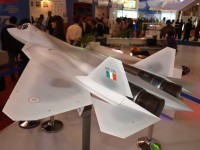
In pride of place at the entrance of HAL’s dominant presence in Hall E at Aero India is a model of the Sukhoi T-50 PKA-FA 5th generation fighter aircraft, now being referred to as the Perspective Multirole Fighter (PMF). Chairman HAL, Dr RK Tyagi, during his press conference on 7 February stated that the project definition phase (PDP) of this joint Indo-Russian program would be completed by March 2013 as HAL engineers are currently positioned with their Russian counterparts, preparing drawings and translation of documentation to Western equivalents. Vayu reports from Aero-India 2013.

The first of three PMF prototypes allocated to India will be positioned at HAL Nasik in 2015, followed by the second in 2017, and third in 2018. These test and development aircraft will be subject to flight evaluation and extensive trials by the IAF, followed by selection of systems, which also differ from the Russian variant.
Production of the PMF will be the responsibility of HAL’s Nasik Division, which will manufacture the airframe, carry out final assembly and conduct flight-testing. The definitive powerplant (as distinct from the current engines on the prototypes) will be produced at HAL Koraput. The first Indian-manufactured PMF will fly in 2022, with deliveries to the Indian Air Force to follow thereafter.

However, there is considerable debate on the practicability of near-simultaneous development of two fifth-generation fighters for the IAF, the PMF in a sense ‘competing’ with India’s Aeronautical Development Agency (ADA)’s Advanced Medium Combat Aircraft (AMCA). Concerns range from duplication of effort to whether India has the resources (both monetary and technical) to carry out both programs through to fruition.

[nonmember]We have added the following details from the presentation provided by HAL at the event. This extra is available as a premium content reserved for our subscribers.[/nonmember]
[ismember]The agreement on the joint development and production of the PMF 5th generation fighter aircraft was signed on October 18, 2007 in Moscow at the 7th session of the Russian-Indian intergovernmental commission on military-technical cooperation. This is the largest joint project of the Russian-Indian military-technical cooperation. The Indian working group of aircraft engineers has been working in Russia since January 2012. A group of Russian specialists currently works in India. In the course of the first stage of the joint project the Russian side has trained Indian specialists and provided them with the original data and software to create a single working environment. Both parties exchange the necessary information.
As of February 2013 the development of conceptual and technical groundwork for the aircraft is almost completed. The contract for that project was signed in December 2010 by the Rosoboronexport, Hindustan Aeronautics Ltd. and Sukhoi Company. A contract for research and development is due to be signed.
The single seat, swing role Prospective Multirole Fighter (PMF) currently under study will be stealthy, ultra-maneuverable fighter aircraft designed for air dominance, capable of engaging targets in the air and for strike role to engage targets on ground and at sea surface, and aerial recce missions, independently or under control from central air or ground command. Fitted with highly integrated avionics, enhanced situational awareness and network-centric warfare capabilities, the PMF will be able independently or as part of combined task forces.
The PMF will have the capacity to perform those missions alone, maintaining the necessary self-defense capability to operate in a dense, hostile denied access, compromising manned interceptors and surface-to-air guided weapons. Yet, it will retain the ability to accurately deliver precision strikes on targets.
The PMF will rely on advanced electronic warfare support systems to enable it to operate in a dense hostile electronic environment comprising airborne and ground based radars and jammers. High degree of agility will also maintain effective close-air support functions, both at medium and low altitude.
Key features for the mission are low observable (stealth) design, supersonic cruise flight regime, high-maneuverability on subsonic and supersonic regimes, improved takeoff and landing characteristics, enabling forward deployment to austere airbases. All 140 aircraft being procured will be single-seat, but the avionic architecture will be designed to support two-seat functionality in a single seat configuration.
The aircraft will be equipped with a range of weapons – air-to-air, air-to-ground, anti-ship and anti-radiation missiles, all stored in internal carriage to maintain stealth. The length of the underbelly weapons bay will be 4.5 meters.
The plane will employ active safety flight control system, providing better fault-tolerant support enabling aircraft to be saved and missions performed even when faults and problems are encountered, or preventing human errors due to malfunctions or mistakes. Improved damage tolerance means aircraft can remain operable under combat conditions for longer periods. Systems health monitoring means the aircraft and vital systems are served based on-condition maintenance, rather on expensive and time-consuming predictive maintenance procedures.
The avionics will employ the most advanced high power computing resources, supporting high level of automation, and intelligent-decision support for decision-making in combat situations. The weapons to be employed will be networked, relying on multi-channel, multi-band and jam-proof links, for defensive, offensive and command and control applications.[/ismember]
















